Abstract
OBJECTIVES: To investigate changes in digital circulation during and after exposure to hand transmitted vibration. By studying two frequencies and two magnitudes of vibration, to investigate the extent to which haemodynamic changes depend on the vibration frequency, the vibration acceleration, and the vibration velocity. METHODS: Finger skin temperature (FST), finger blood flow (FBF), and finger systolic pressure were measured in the fingers of both hands in eight healthy men. Indices of digital vasomotor tone-such as critical closing pressure and vascular resistance-were estimated by pressure-flow curves obtained with different hand heights. With a static load of 10 N, the right hand was exposed for 30 minutes to each of the following root mean squared (rms) acceleration magnitudes and frequencies of vertical vibration: 22 m.s-2 at 31.5 Hz, 22 m.s-2 at 125 Hz, and 87 m.s-2 at 125 Hz. A control condition consisted of exposure to the static load only. The measures of digital circulation and vasomotor tone were taken before exposure to the vibration and the static load, and at 0, 20, 40, and 60 minutes after the end of each exposure. RESULTS: Exposure to static load caused no significant changes in FST, FBF, or indices of vasomotor tone in either the vibrated right middle finger or the non-vibrated left middle finger. In both fingers, exposure to vibration of 125 Hz and 22 m.s-2 produced a greater reduction in FBF and a greater increase in vasomotor tone than did vibration of 31.5 Hz and 22 m.s-2. In the vibrated right finger, exposure to vibration of 125 Hz and 87 m.s-2 provoked an immediate vasodilation which was followed by vasoconstriction during recovery. The non-vibrated left finger showed a significant increase in vasomotor tone throughout the 60 minute period after the end of vibration exposure. CONCLUSIONS: The digital circulatory response to acute vibration depends upon the magnitude and frequency of the vibration stimulus. Vasomotor mechanisms, mediated both centrally and locally, are involved in the reaction of digital vessels to acute vibration. The pattern of the haemodynamic changes in the fingers exposed to the vibration frequencies used in this study do not seem to support the frequency weighting assumed in the current international standard ISO 5349.
Full text
PDF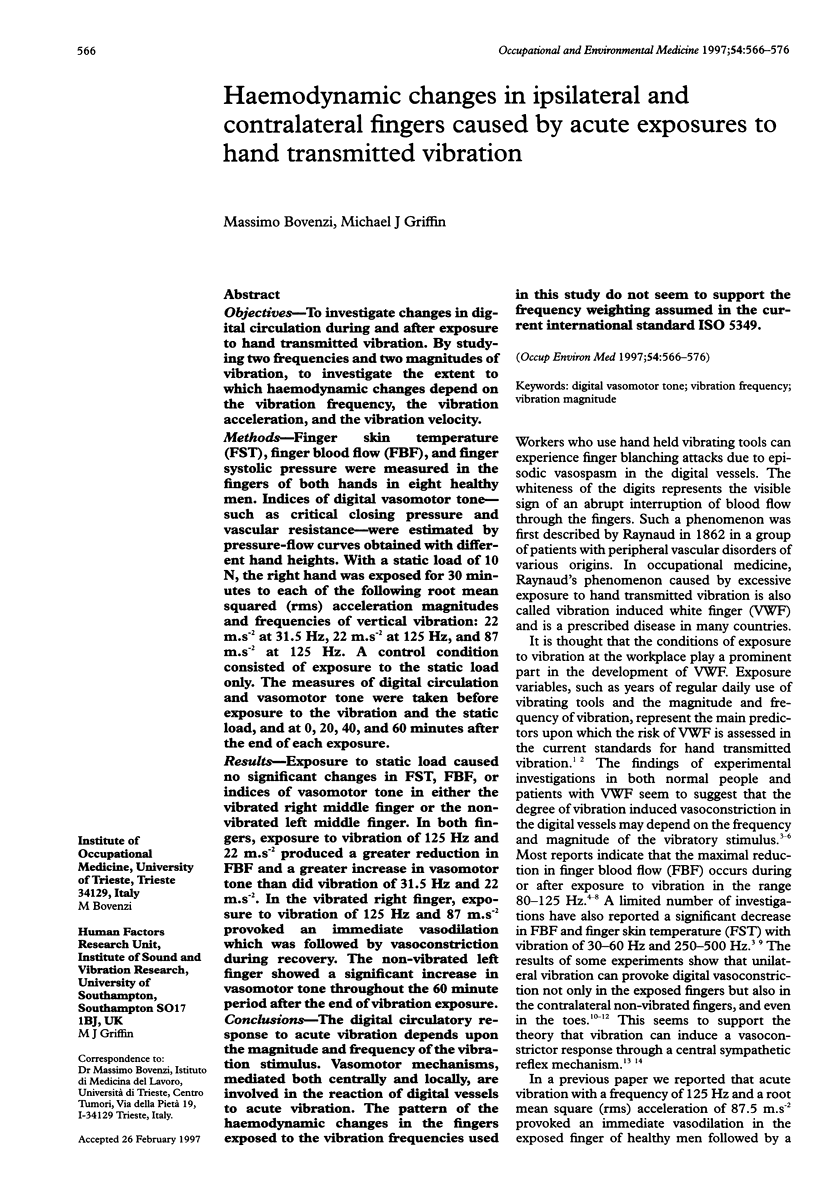
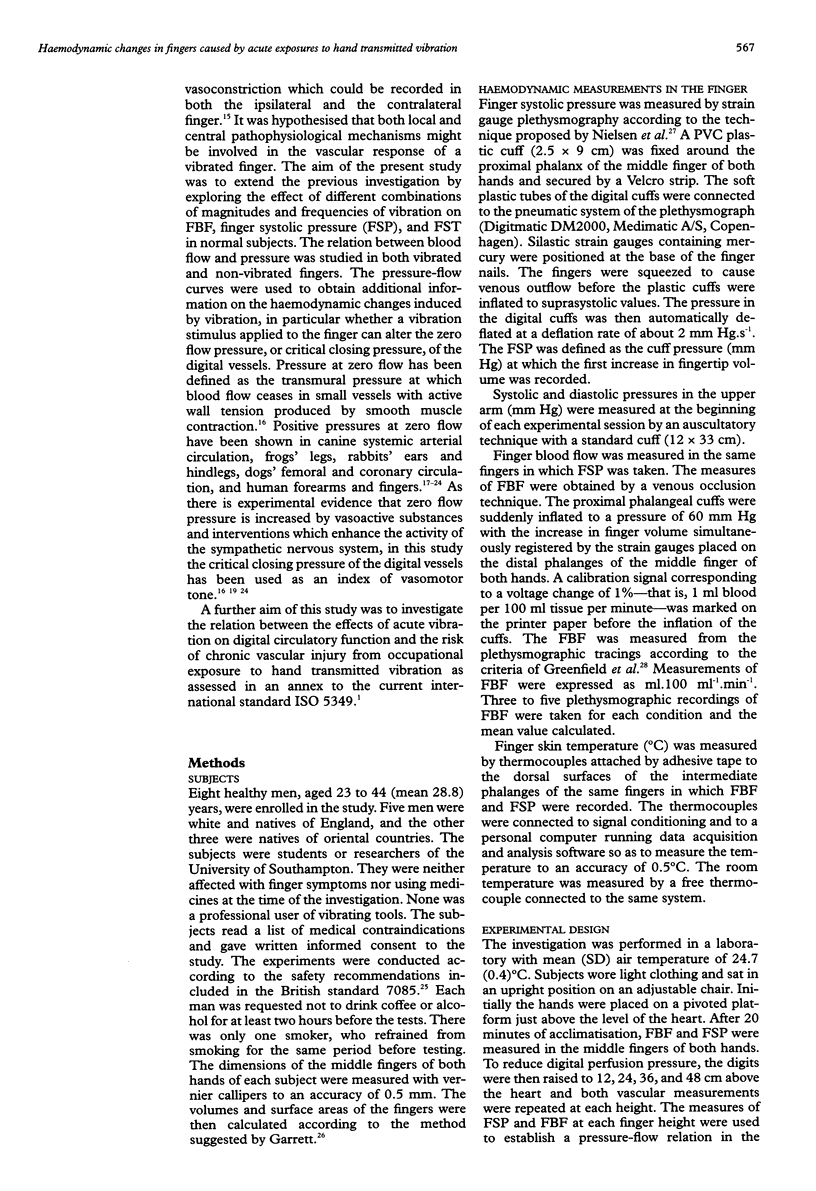
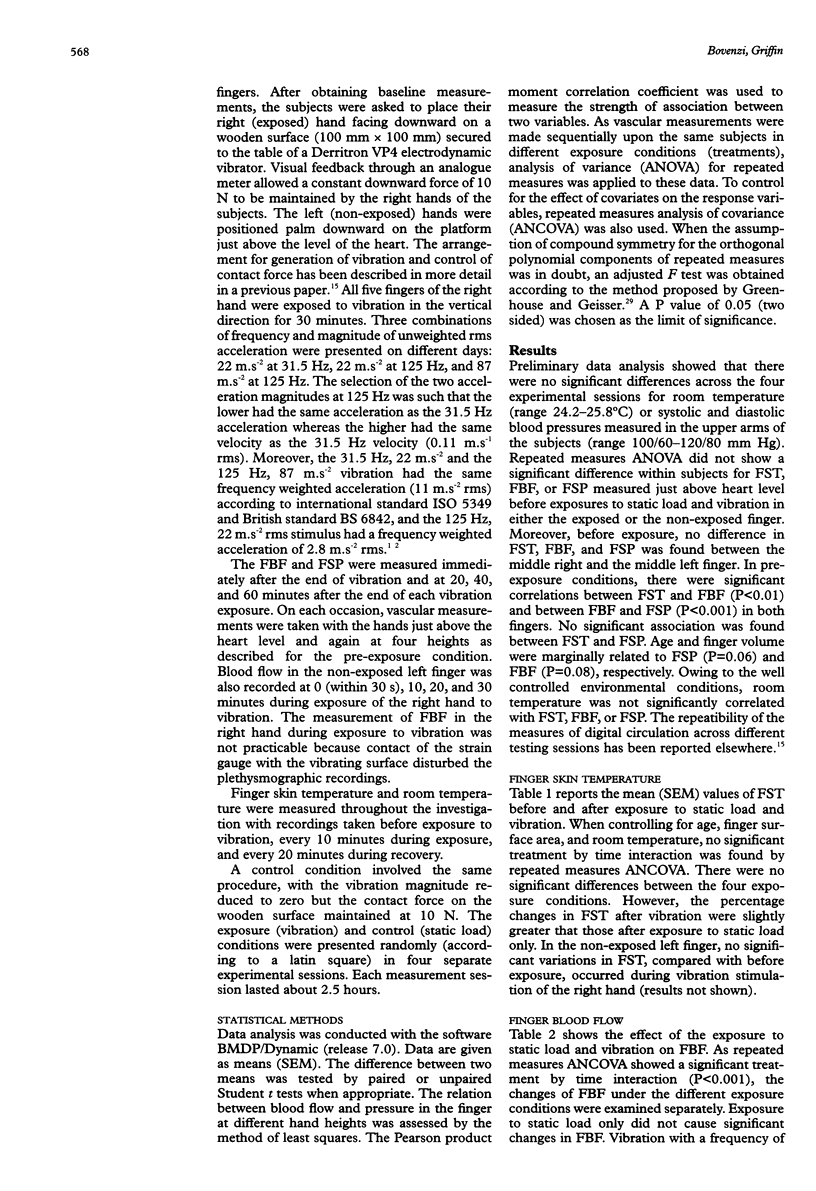
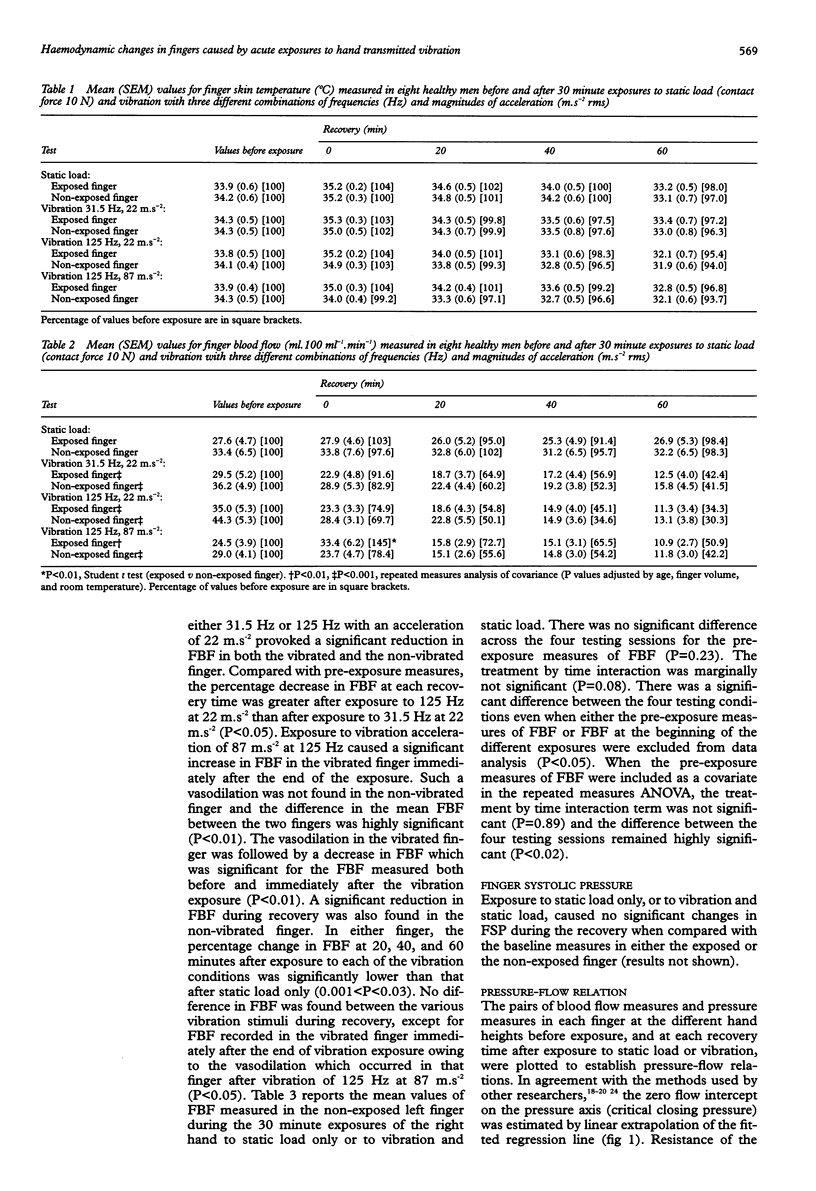
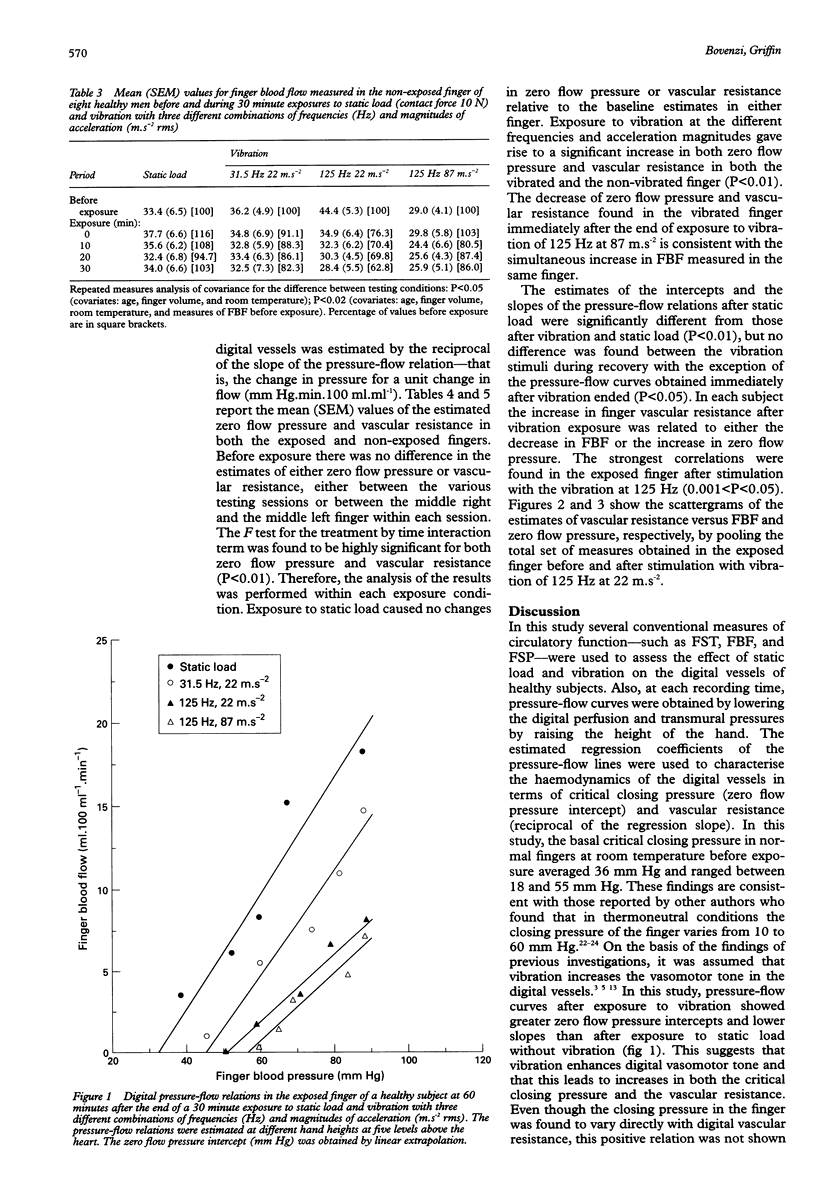

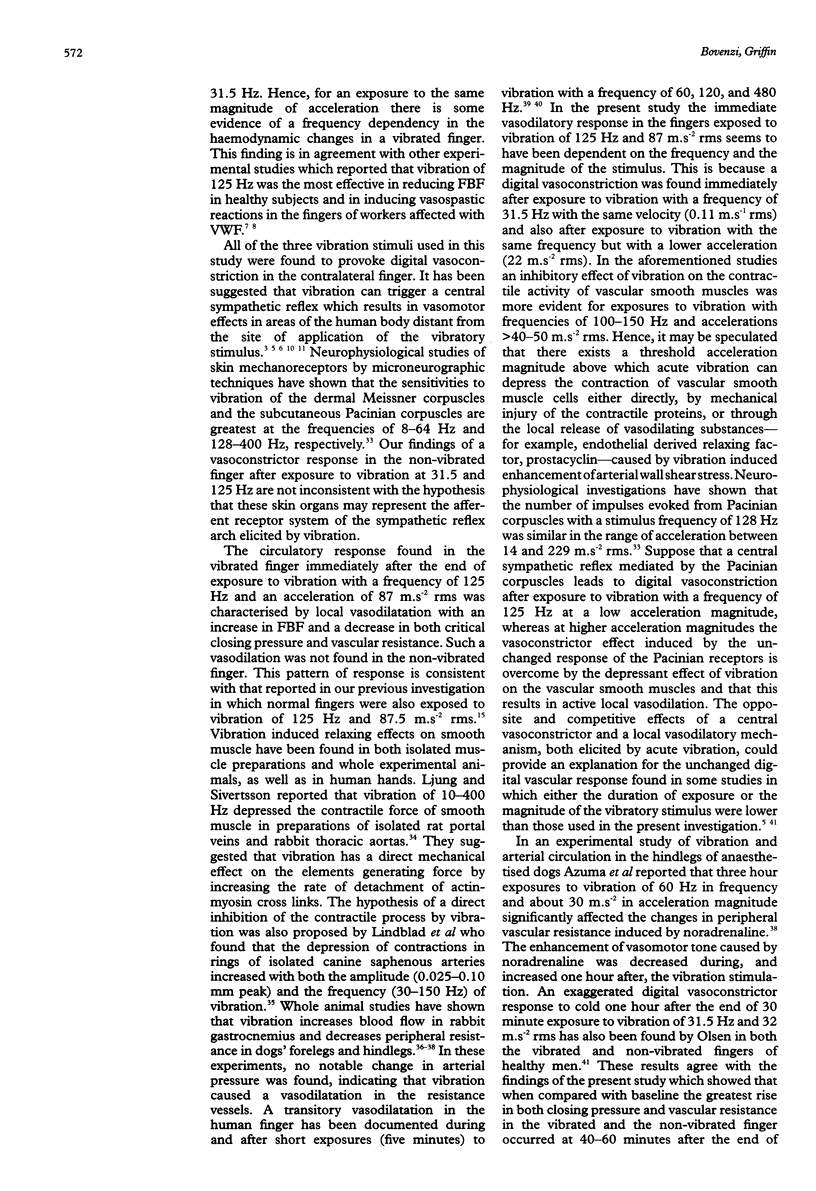
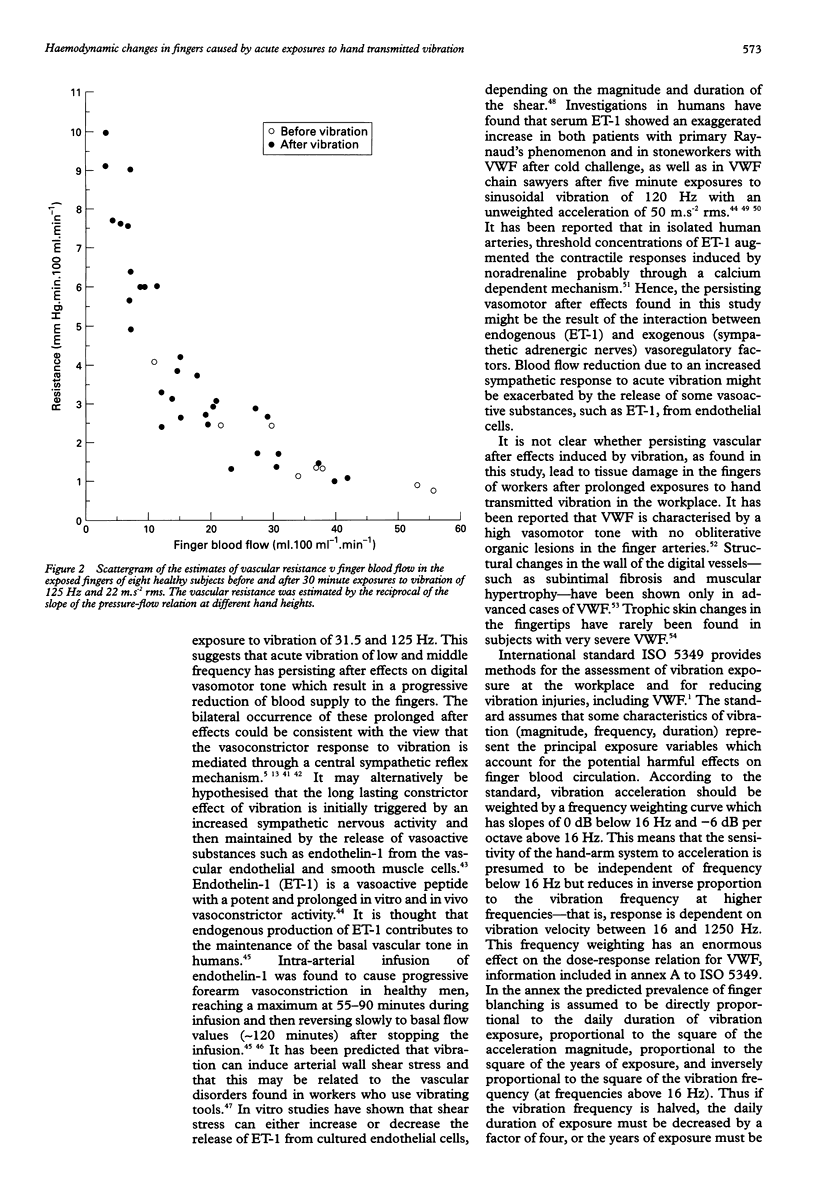
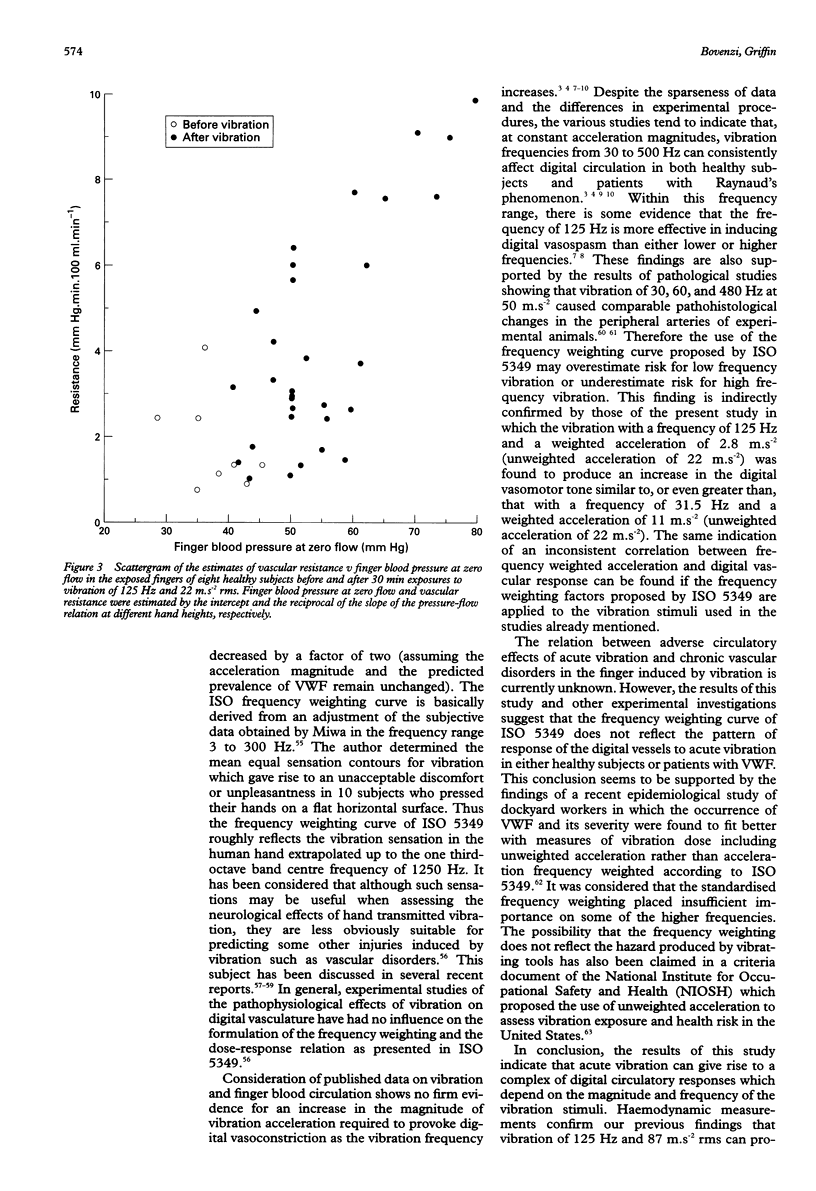
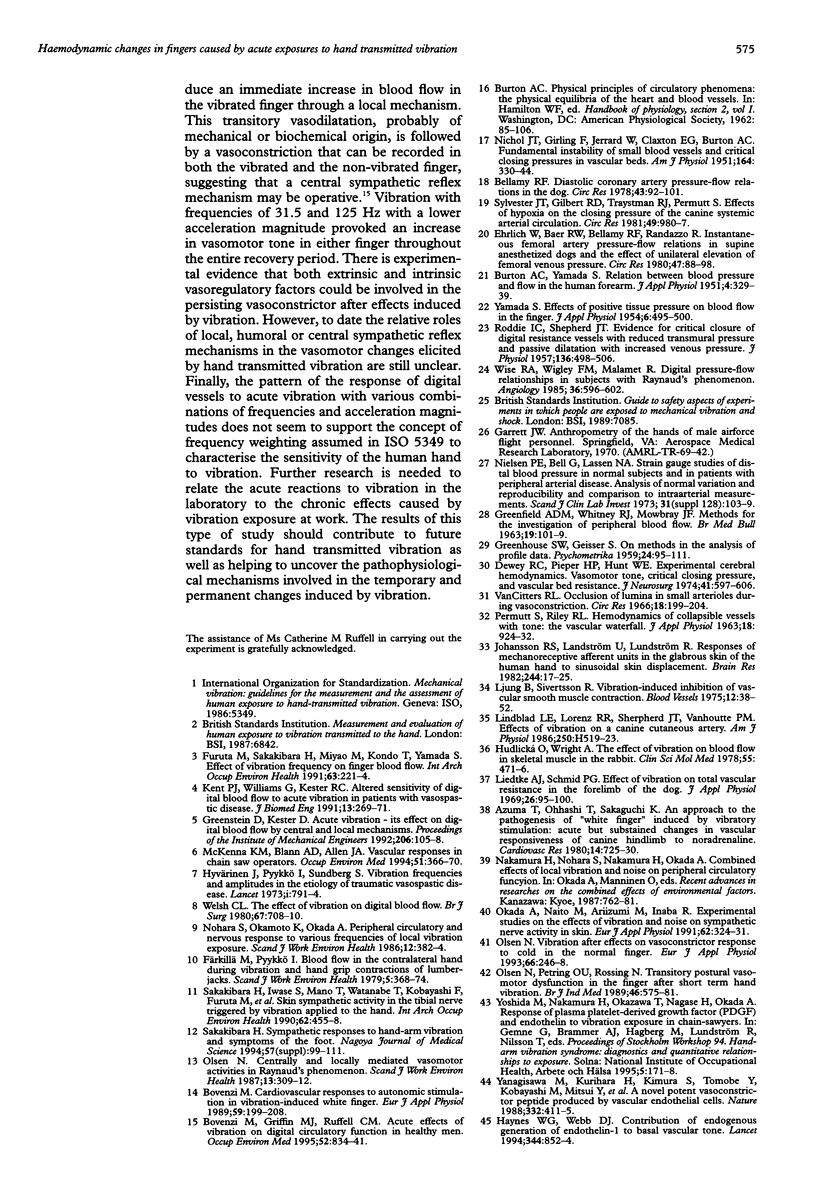
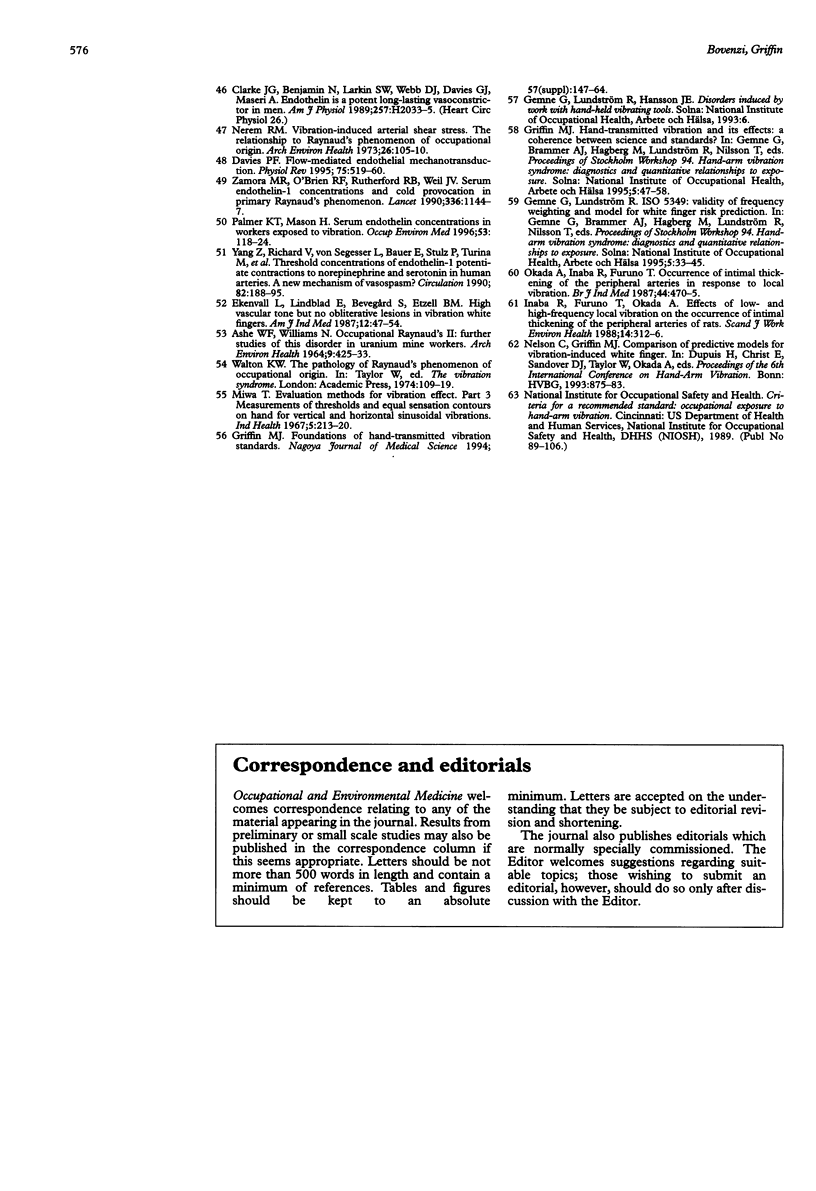
Selected References
These references are in PubMed. This may not be the complete list of references from this article.
- ASHE W. F., WILLIAMS N. OCCUPATIONAL RAYNAUD'S. II. FURTHER STUDIES OF THIS DISORDER IN URANIUM MINE WORKERS. Arch Environ Health. 1964 Oct;9:425–433. doi: 10.1080/00039896.1964.10663861. [DOI] [PubMed] [Google Scholar]
- Azuma T., Ohhashi T., Sakaguchi M. An approach to the pathogenesis of "white finger" induced by vibratory stimulation: acute but sustained changes in vascular responsiveness of canine hindlimb to noradrenaline. Cardiovasc Res. 1980 Dec;14(12):725–730. doi: 10.1093/cvr/14.12.725. [DOI] [PubMed] [Google Scholar]
- BURTON A. C., YAMADA S. Relation between blood pressure and flow in the human forearm. J Appl Physiol. 1951 Nov;4(5):329–339. doi: 10.1152/jappl.1951.4.5.329. [DOI] [PubMed] [Google Scholar]
- Bellamy R. F. Diastolic coronary artery pressure-flow relations in the dog. Circ Res. 1978 Jul;43(1):92–101. doi: 10.1161/01.res.43.1.92. [DOI] [PubMed] [Google Scholar]
- Bovenzi M. Cardiovascular responses to autonomic stimuli in workers with vibration-induced white finger. Eur J Appl Physiol Occup Physiol. 1989;59(3):199–208. doi: 10.1007/BF02386188. [DOI] [PubMed] [Google Scholar]
- Bovenzi M., Griffin M. J., Ruffell C. M. Acute effects of vibration on digital circulatory function in healthy men. Occup Environ Med. 1995 Dec;52(12):834–841. doi: 10.1136/oem.52.12.834. [DOI] [PMC free article] [PubMed] [Google Scholar]
- Clarke J. G., Benjamin N., Larkin S. W., Webb D. J., Davies G. J., Maseri A. Endothelin is a potent long-lasting vasoconstrictor in men. Am J Physiol. 1989 Dec;257(6 Pt 2):H2033–H2035. doi: 10.1152/ajpheart.1989.257.6.H2033. [DOI] [PubMed] [Google Scholar]
- Davies P. F. Flow-mediated endothelial mechanotransduction. Physiol Rev. 1995 Jul;75(3):519–560. doi: 10.1152/physrev.1995.75.3.519. [DOI] [PMC free article] [PubMed] [Google Scholar]
- Dewey R. C., Pieper H. P., Hunt W. E. Experimental cerebral hemodynamics. Vasomotor tone, critical closing pressure, and vascular bed resistance. J Neurosurg. 1974 Nov;41(5):597–606. doi: 10.3171/jns.1974.41.5.0597. [DOI] [PubMed] [Google Scholar]
- Ehrlich W., Baer R. W., Bellamy R. F., Randazzo R. Instantaneous femoral artery pressure-flow relations in supine anesthetized dogs and the effect of unilateral elevation of femoral venous pressure. Circ Res. 1980 Jul;47(1):88–98. doi: 10.1161/01.res.47.1.88. [DOI] [PubMed] [Google Scholar]
- Ekenvall L., Lindblad L. E., Bevegård S., Etzell B. M. High vascular tone but no obliterative lesions in vibration white fingers. Am J Ind Med. 1987;12(1):47–54. doi: 10.1002/ajim.4700120106. [DOI] [PubMed] [Google Scholar]
- Furuta M., Sakakibara H., Miyao M., Kondo T., Yamada S. Effect of vibration frequency on finger blood flow. Int Arch Occup Environ Health. 1991;63(3):221–224. doi: 10.1007/BF00381572. [DOI] [PubMed] [Google Scholar]
- Färkkilä M., Pyykkö I. Blood flow in the contralateral hand during vibration and hand grip contractions of lumberjacks. Scand J Work Environ Health. 1979 Dec;5(4):368–374. doi: 10.5271/sjweh.2644. [DOI] [PubMed] [Google Scholar]
- GREENFIELD A. D., WHITNEY R. J., MOWBRAY J. F. Methods for the investigation of peripheral blood flow. Br Med Bull. 1963 May;19:101–109. doi: 10.1093/oxfordjournals.bmb.a070026. [DOI] [PubMed] [Google Scholar]
- Griffin M. J. Foundations of hand-transmitted vibration standards. Nagoya J Med Sci. 1994 May;57 (Suppl):147–164. [PubMed] [Google Scholar]
- Haynes W. G., Webb D. J. Contribution of endogenous generation of endothelin-1 to basal vascular tone. Lancet. 1994 Sep 24;344(8926):852–854. doi: 10.1016/s0140-6736(94)92827-4. [DOI] [PubMed] [Google Scholar]
- Huclická O., Wright A. The effect of vibration on blood flow in skeletal muscle in the rabbit. Clin Sci Mol Med. 1978 Nov;55(5):471–476. doi: 10.1042/cs0550471. [DOI] [PubMed] [Google Scholar]
- Hyvärinen J., Pyykkö I., Sundberg S. Vibration frequencies and amplitudes in the aetiology of traumatic vasospastic disease. Lancet. 1973 Apr 14;1(7807):791–794. doi: 10.1016/s0140-6736(73)90598-9. [DOI] [PubMed] [Google Scholar]
- Inaba R., Furuno T., Okada A. Effects of low- and high-frequency local vibration on the occurrence of intimal thickening of the peripheral arteries of rats. Scand J Work Environ Health. 1988 Oct;14(5):312–316. doi: 10.5271/sjweh.1914. [DOI] [PubMed] [Google Scholar]
- Johansson R. S., Landström U., Lundström R. Responses of mechanoreceptive afferent units in the glabrous skin of the human hand to sinusoidal skin displacements. Brain Res. 1982 Jul 22;244(1):17–25. doi: 10.1016/0006-8993(82)90899-x. [DOI] [PubMed] [Google Scholar]
- Liedtke A. J., Schmid P. G. Effect of vibration on total vascular resistance in the forelimb of the dog. J Appl Physiol. 1969 Jan;26(1):95–100. doi: 10.1152/jappl.1969.26.1.95. [DOI] [PubMed] [Google Scholar]
- Lindblad L. E., Lorenz R. R., Shepherd J. T., Vanhoutte P. M. Effect of vibration on a canine cutaneous artery. Am J Physiol. 1986 Mar;250(3 Pt 2):H519–H523. doi: 10.1152/ajpheart.1986.250.3.H519. [DOI] [PubMed] [Google Scholar]
- Ljung B., Sivertsson R. Vibration-induced inhibition of vascular smooth muscle contraction. Blood Vessels. 1975;12(1):38–52. doi: 10.1159/000158037. [DOI] [PubMed] [Google Scholar]
- McKenna K. M., Blann A. D., Allen J. A. Vascular responses in chain saw operators. Occup Environ Med. 1994 Jun;51(6):366–370. doi: 10.1136/oem.51.6.366. [DOI] [PMC free article] [PubMed] [Google Scholar]
- NICHOL J., GIRLING F., JERRARD W., CLAXTON E. B., BURTON A. C. Fundamental instability of the small blood vessels and critical closing pressures in vascular beds. Am J Physiol. 1951 Feb;164(2):330–344. doi: 10.1152/ajplegacy.1951.164.2.330. [DOI] [PubMed] [Google Scholar]
- Nerem R. M. Vibration-induced arterial shear stress: the relationship to Raynaud's phenomenon. Arch Environ Health. 1973 Mar;26(3):105–110. doi: 10.1080/00039896.1973.10666236. [DOI] [PubMed] [Google Scholar]
- Nielsen P. E., Bell G., Lassen N. A. Strain gauge studies of distal blood pressure in normal subjects and in patients with peripheral arterial disease. Analysis of normal variation and reproducibility and comparison to intraarterial measurements. Scand J Clin Lab Invest Suppl. 1973;128:103–109. [PubMed] [Google Scholar]
- Okada A., Inaba R., Furuno T. Occurrence of intimal thickening of the peripheral arteries in response to local vibration. Br J Ind Med. 1987 Jul;44(7):470–475. doi: 10.1136/oem.44.7.470. [DOI] [PMC free article] [PubMed] [Google Scholar]
- Okada A., Naito M., Ariizumi M., Inaba R. Experimental studies on the effects of vibration and noise on sympathetic nerve activity in skin. Eur J Appl Physiol Occup Physiol. 1991;62(5):324–331. doi: 10.1007/BF00634967. [DOI] [PubMed] [Google Scholar]
- Olsen N. Centrally and locally mediated vasomotor activities in Raynaud's phenomenon. Scand J Work Environ Health. 1987 Aug;13(4):309–312. doi: 10.5271/sjweh.2047. [DOI] [PubMed] [Google Scholar]
- Olsen N., Petring O. U., Rossing N. Transitory postural vasomotor dysfunction in the finger after short term hand vibration. Br J Ind Med. 1989 Aug;46(8):575–581. doi: 10.1136/oem.46.8.575. [DOI] [PMC free article] [PubMed] [Google Scholar]
- Olsen N. Vibration aftereffects on vasoconstrictor response to cold in the normal finger. Eur J Appl Physiol Occup Physiol. 1993;66(3):246–248. doi: 10.1007/BF00235101. [DOI] [PubMed] [Google Scholar]
- PERMUTT S., RILEY R. L. HEMODYNAMICS OF COLLAPSIBLE VESSELS WITH TONE: THE VASCULAR WATERFALL. J Appl Physiol. 1963 Sep;18:924–932. doi: 10.1152/jappl.1963.18.5.924. [DOI] [PubMed] [Google Scholar]
- Palmer K. T., Mason H. Serum endothelin concentrations in workers exposed to vibration. Occup Environ Med. 1996 Feb;53(2):118–124. doi: 10.1136/oem.53.2.118. [DOI] [PMC free article] [PubMed] [Google Scholar]
- RODDIE I. C., SHEPHERD J. T. Evidence for critical closure of digital resistance vessels with reduced transmural pressure and passive dilatation with increased venous pressure. J Physiol. 1957 May 23;136(3):498–506. doi: 10.1113/jphysiol.1957.sp005776. [DOI] [PMC free article] [PubMed] [Google Scholar]
- Sakakibara H., Iwase S., Mano T., Watanabe T., Kobayashi F., Furuta M., Kondo T., Miyao M., Yamada S. Skin sympathetic activity in the tibial nerve triggered by vibration applied to the hand. Int Arch Occup Environ Health. 1990;62(6):455–458. doi: 10.1007/BF00379063. [DOI] [PubMed] [Google Scholar]
- Sakakibara H. Sympathetic responses to hand-arm vibration and symptoms of the foot. Nagoya J Med Sci. 1994 May;57 (Suppl):99–111. [PubMed] [Google Scholar]
- Sylvester J. T., Gilbert R. D., Traystman R. J., Permutt S. Effects of hypoxia on the closing pressure of the canine systemic arterial circulation. Circ Res. 1981 Oct;49(4):980–987. doi: 10.1161/01.res.49.4.980. [DOI] [PubMed] [Google Scholar]
- Welsh C. L. The effect of vibration on digital blood flow. Br J Surg. 1980 Oct;67(10):708–710. doi: 10.1002/bjs.1800671009. [DOI] [PubMed] [Google Scholar]
- Wise R. A., Wigley F. M., Malamet R. Digital pressure-flow relationships in subjects with Raynaud's phenomenon. Angiology. 1985 Sep;36(9):596–602. doi: 10.1177/000331978503600902. [DOI] [PubMed] [Google Scholar]
- YAMADA S. Effects of positive tissue pressure on blood flow of the finger. J Appl Physiol. 1954 Feb;6(8):495–500. doi: 10.1152/jappl.1954.6.8.495. [DOI] [PubMed] [Google Scholar]
- Yanagisawa M., Kurihara H., Kimura S., Tomobe Y., Kobayashi M., Mitsui Y., Yazaki Y., Goto K., Masaki T. A novel potent vasoconstrictor peptide produced by vascular endothelial cells. Nature. 1988 Mar 31;332(6163):411–415. doi: 10.1038/332411a0. [DOI] [PubMed] [Google Scholar]
- Yang Z. H., Richard V., von Segesser L., Bauer E., Stulz P., Turina M., Lüscher T. F. Threshold concentrations of endothelin-1 potentiate contractions to norepinephrine and serotonin in human arteries. A new mechanism of vasospasm? Circulation. 1990 Jul;82(1):188–195. doi: 10.1161/01.cir.82.1.188. [DOI] [PubMed] [Google Scholar]
- Zamora M. R., O'Brien R. F., Rutherford R. B., Weil J. V. Serum endothelin-1 concentrations and cold provocation in primary Raynaud's phenomenon. Lancet. 1990 Nov 10;336(8724):1144–1147. doi: 10.1016/0140-6736(90)92766-b. [DOI] [PubMed] [Google Scholar]


